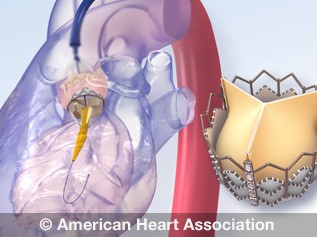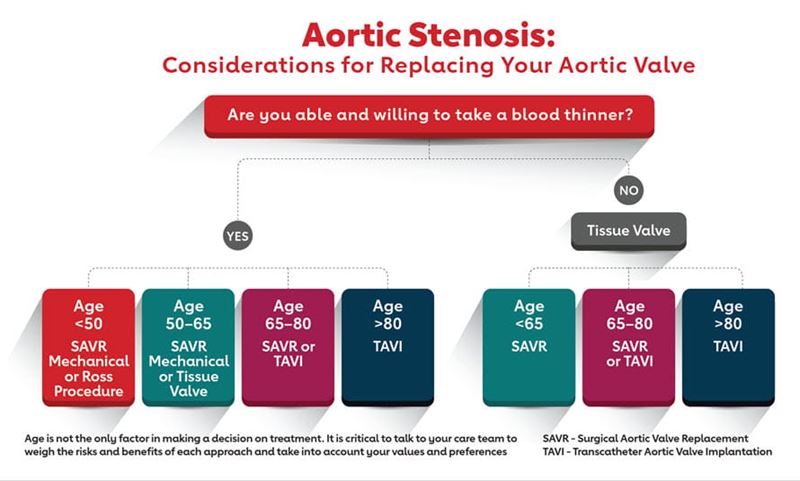Less Invasive Heart Valve Surgery Options
One important reason to track any possible valve disease-related symptoms and get regular checkups – especially as we age – is to ensure any developing valve problems can be identified and treated as soon as possible.
Medications can be prescribed to increase the heart’s ability to pump blood, which may help compensate for a valve that isn’t working correctly. However, a diseased heart valve is a mechanical problem that can’t be fixed with medication alone. Surgery is often needed to repair or replace the damaged valve. Untreated valve disease may lead to decreased heart function and limit future treatment options. It’s important to discuss any symptoms with your health care professional.
What if open-heart surgery is too risky for me?
There’s good news if you or someone you love needs a new heart valve and you have been told open-heart surgery is too risky. People with severe aortic stenosis may be good candidates for a less invasive replacement called a transcatheter aortic valve implantation (TAVI), also called transcatheter aortic valve replacement (TAVR). If you have mitral regurgitation, you may be a candidate for transcatheter mitral valve repair, also known as transcatheter edge-to-edge repair (TEER).

TAVI for aortic stenosis
This minimally invasive procedure is similar to placing a stent inside an artery. A catheter, a thin wire or tube, is threaded through an artery to the diseased valve and a new valve is placed inside the old valve. Some implanted valves are “spring-loaded” and expand themselves. Others are expanded using a balloon. Once the new valve is expanded, it pushes the old valve leaflets out of the way and the replacement valve takes over the job of regulating blood flow.
The TAVI procedure is performed using one of several approaches, allowing the cardiologist or surgeon to choose the best and safest way to access the valve. The two most common approaches are transfemoral and transapical:
- Transfemoral: enters through the femoral artery (large artery in the groin), which does not require a surgical incision in the chest
- Transapical: uses a minimally invasive surgical approach with a small incision in the chest and enters the heart through the tip of the left ventricle called the apex.
View Aortic Stenosis: Considerations for Replacing Your Aortic Valve (PDF)
Transcatheter edge-to-edge repair (TEER) for mitral regurgitation
During this minimally invasive procedure, doctors access the mitral valve with a thin tube called a catheter that is guided through a vein in your leg to reach your heart.
A small, implanted clip is attached to your mitral valve to help it close more completely. This helps to restore normal blood flow through your heart.
Although minimally invasive procedures are not without risks, they provide beneficial treatment options to people who would not have been considered for valve replacement. A patient’s experience with TAVI or TEER may be comparable to a coronary angiogram in terms of recovery. You’ll likely have a shorter hospital stay after TAVI or TEER compared to a surgical valve procedure.
Are there other types of minimally invasive repairs or replacement options?
Yes. There are other minimally invasive valve surgery techniques including video-assisted surgery, robotic-assisted surgery or surgeries performed with an endoscope. Your health care team will discuss available treatment options for your valve condition. Together you can choose what’s best for you.
What are the benefits and considerations for a TAVI or other minimally invasive procedure?
Benefits of minimally invasive treatment options may include:
- Lower risk of infection
- Less trauma to the chest and heart muscle tissue
- Reduced length of hospital stay
- Decreased recovery time
Of course, everyone wants less pain and a shorter recovery time. But everyone also wants the best possible outcome and the longest, healthiest life as a result. Those factors along with a person’s age, health history, type and severity of the valve problem and overall health will factor into selecting the best surgical option for any patient.
Why doesn't everyone get a minimally invasive procedure?
Your goal — and the goal of your health care team — is to get the best and safest treatment possible for you. That means tailoring the treatment to your heart, your valve disease, your age, your general health and other factors unique to you. Because we’re all different, not everyone with the same kind of valve disease needs the same kind of repair, the same kind or size of replacement valve or the same approach.
Be sure to print our surgery checklist in English (PDF)(link opens in new window) (also available is a surgery checklist in Spanish (PDF)) and recovery tracker in English (PDF)(link opens in new window) (also available is a recovery tracker in Spanish (PDF)) to help you prepare for the possible experience as you begin the journey toward feeling better.
Is there financial assistance available for people in need of TAVI or TEER?
TAVI and TEER are approved and available for qualifying patients receiving Medicare and Medicaid. More information is available on the Centers for Medicare and Medicaid Services (CMS) for TAVI and TEER. Learn more about health care laws and government programs seeking to provide affordable coverage at the HealthCare.gov website. The Heart Valve CareLine can help you navigate the insurance and medical world as it relates to your diagnosis.






